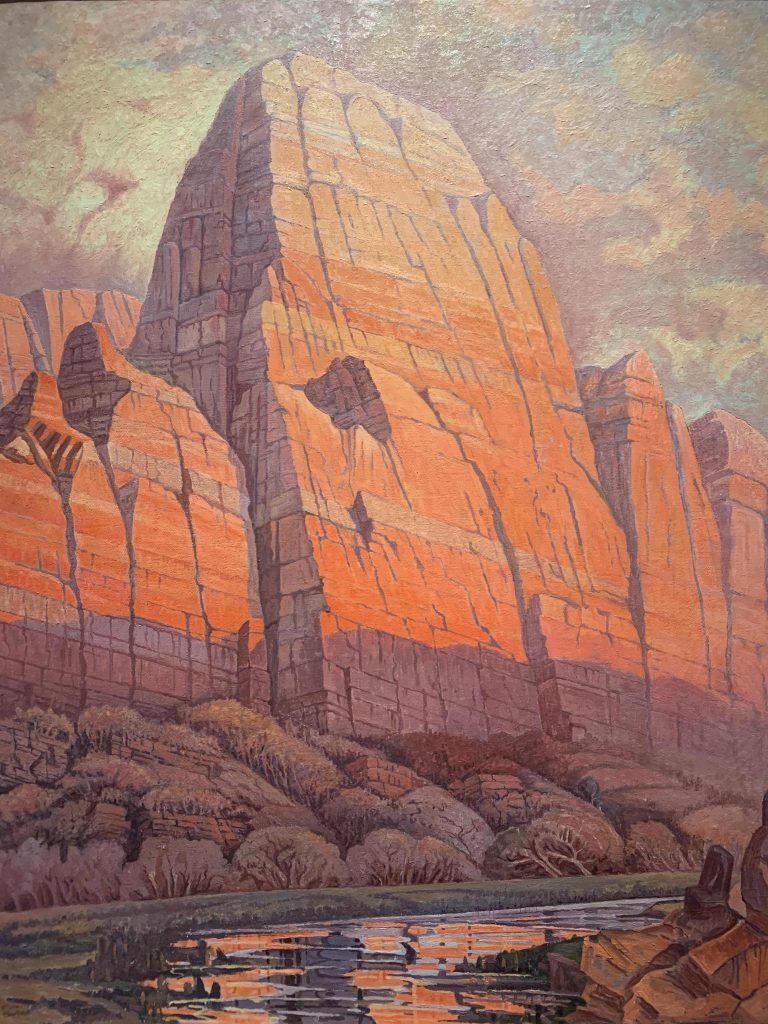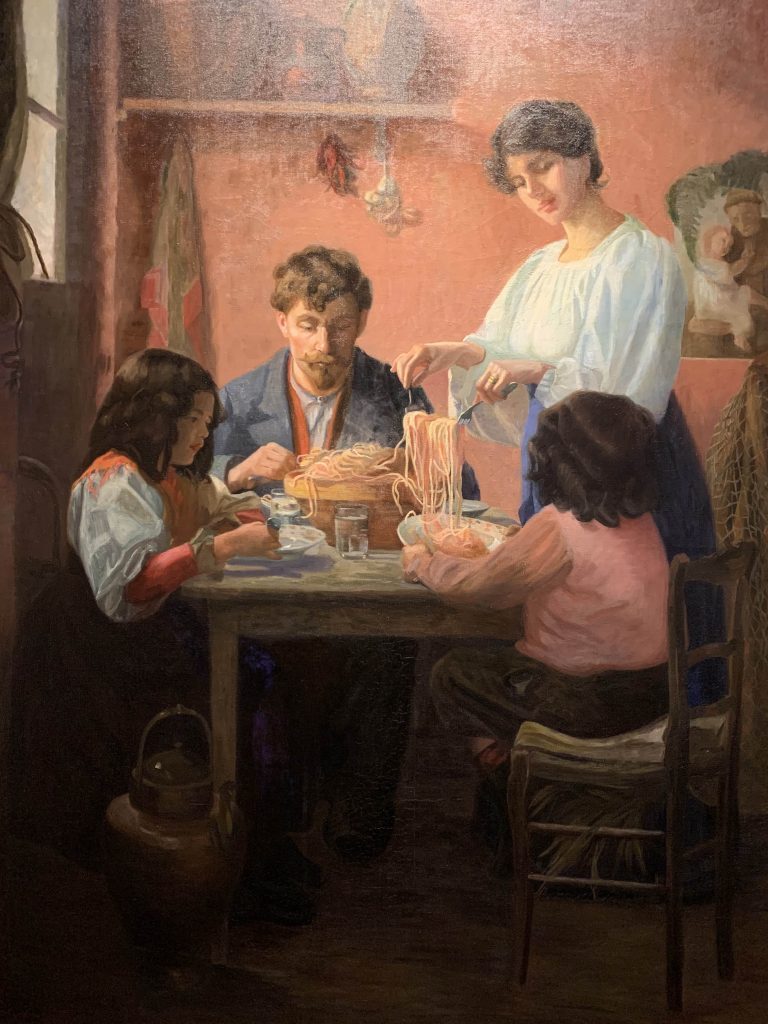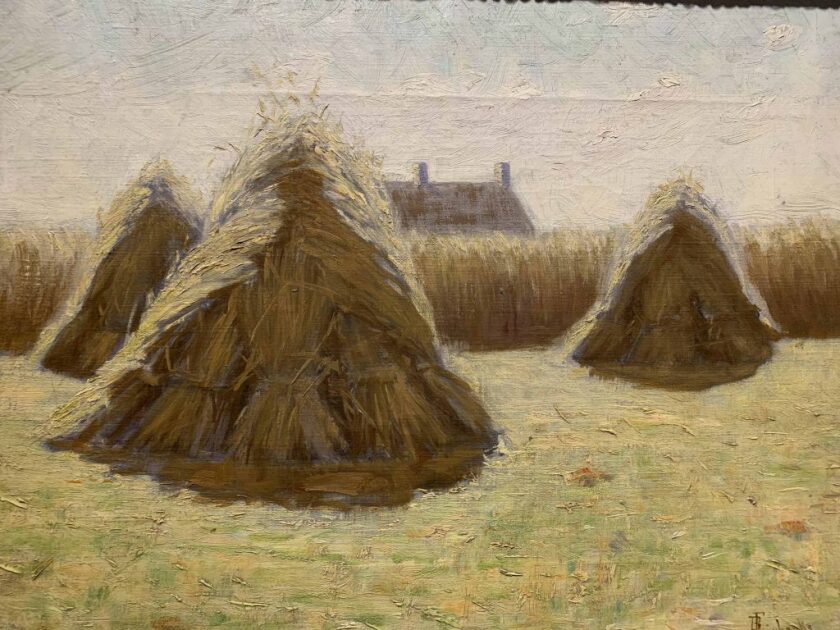Beginnings
Many of the early works that established the University collection were those of Utah artists. Though for some, names like John Hafen, John B. Fairbanks, James Harwood, Rose Hartwell, and J. Willard Clawson may not stand out in the annals of art history, they represent some of the finest Utah artists of their day, and their works continue to stand the test of time.
Some of these artists donated their works, eager to contribute to student enrichment. Most of the works, however, were garnered through negotiations by university educators and administrators in a way that was financially beneficial for the artists and the school.
Particularly during the 1930s, Bent Franklin Larsen, known as “B.F.,” an artists and faculty member, worked tirelessly to bring works by Utah artists to the school. Many consider B.F. Larsen to the founder of the university’s collection.

In this endearing scene, Edwin Evans shows his young sons feeding a calf in the yard of their home in Lehi, Utah. Though he did not begin his artistic career until he was nearly 30 years old, Evans became an important personality in early Utah art. In 1888, The Church of Jesus Christ of Latter-day Saints sponsored his training at the Académie Julian in Paris. These lessons and his experience painting in the French countryside honed his sophistication with the human form as well as a luminous Impressionist style, seen here in the bright sunlight and dappled shade, painted in subtly broken brushstrokes.
This painting was donated to the University by Maria Burnham Winder, wife of John R. Winder, a prominent civic leader and member of the First Presidency of The Church of Jesus Christ of Latter-day Saints from 1901-1910. Winder received the painting as a gift for his leadership of the Utah State Fair, a venue in which Evans often exhibited.

Ella Peacock’s painting of an old dance hall in the small farming community of Millburn, Utah, captures a relic of days past. A native of Pennsylvania, Ella Peacock relocated to Spring City, Utah, in 1970. As Ella said, “the first time I saw this area I knew I could paint the rest of my days here.” Ella loved the immediacy of painting outdoors, but often created her works in her car, as she could paint in any weather without interruption from curious passersby.
In 1987, Ella Peacock donated a large portion of her art collection, over 60 paintings with handmade frames, to Brigham Young University. She continued to paint until her death in 1999.

BYU alumnus and former faculty member James C. Christensen is best known for whimsical yet insightful images inspired by fairy tales, legends, and his Christian faith. His imaginative paintings include characters like trolls, mermaids, angels, and this amusing musician.
Christensen contrasts the figure’s incredibly thin fingers, legs, music stands, and brass instrument with his voluminous and extravagant clothing as he performs a two-part piece written on separate pieces of sheet music. The disarming wit and impossibility of the quirky musician’s task invite humor as well as reflection on our own profound human dilemmas: how can one person be expected to play two parts?

James Taylor Harwood was the first aspiring Utah artist to study in Paris, in 1888, eventually returning to Utah to become an influential artist and teacher. His Young Constructors masterfully merges his impressionist sensitivity to light with his interest in depictions of everyday life.
Harwood’s young son Willard, who was continually inventing things, was both inspiration and model for this painting of inquisitive boys. The standing boy works on a steam engine that powers a crane. The standing boy works on a steam engine that powers a crane. The seated figure is whittling, a wooden whirligig-like contraption next to him on the floor. The youthful engineers are completely absorbed in their labors, giving them a focused a sobriety that belies their age. The university purchased this and other paintings from Harwood in 1937.

This serene view along a lush river bank evidences John Hafen’s interest in light, gained from his studies of French Impressionism abroad. Hafen was among those artists who, in 1890, petitioned the First Presidency of the Church of Jesus Christ of Latter-day Saints to finance his study in Paris. As with his other landscape images, this painting imbues the scene with a reverential tone, reflecting his belief that by sincerely studying nature, an artist communes with the divine.
The Sycamore Tree was the first painting owned by Brigham Young University, gifted to the school by J. William Knight in 1909 for the beginnings of an art gallery. Hafen likely encouraged this donation, as he was present at the occasion and believed strongly in the necessity of art to educate and elevate young minds. As president to the Utah Art Association, Hafen and other artists donated works to establish a gallery at Springville High School, a collection which later became the Springville Museum of Art. Unfortunately, Hafen was just beginning to achieve financial success about this time, a year before his death from pneumonia.

Leconte Stewart captured true-to-life views of rural Utah throughout his long career. He often created his paintings on-site so as to capture the sensation of the place, as in this stocky Depression-era home in Riverdale, Utah. Stewart’s image exudes the atmosphere of a summer afternoon with the amber light and the long shadows of the telephone poles rake across the dirt and road.
Stewart’s title, Western Gingerbread, may refer to the cinnamon tones of earth and house, or cleverly allude to the simple, low eaves of the modest home as Utah’s version of the gingerbread style houses popular in the 19th century. He could also perhaps be jokingly referencing the intricate network of telephone shafts and wires that adorn the view as the home’s decorative lacing.

Phillip Barkdull developed an energetic, modernist approach that stood out among Utah artists. He painted this vibrant view of the Great White Throne while visiting Zion National Park in the late 1920s, about the time he studied with fauvist landscape painter, Birger Sandzen. The glowing reds, oranges, and golds transform the towering monolith and stream into a surreal wash of desert light.
Barkdull taught art in secondary schools throughout Utah, including two decades as teacher and administrator of Logan’s art programs. He also taught for a year at BYU, his alma mater. Barkdull’s wife gifted this vivid landscape to the university in 1968, the same year as the artist’s death.

In 1897, Rose Hartwell left Utah at the encouragement of local art teachers, to pursue training in Paris. While abroad, she spent 18 months traveling through Italy, gaining experiences that inspired this scene of an Italian family eating a humble pasta meal. With its appealing peasant subject and fine execution, this painting was later accepted for display in the prestigious Paris Salon.
Middle-aged and independent, Hartwell continued to travel throughout Europe, developing her artistry. She returned to Salt Lake City and married in 1914, but passed away just a few years later. In 1941, the university purchased a large collection of Hartwell’s works that had remained in her husband’s estate following his death.

Few artists have captured the energetic force of Utah’s mountains as Doug Snow. Snow’s landscape paintings merge his early training in Abstract Expressionism in 1950s New York City with his longtime intimacy with the dramatic landscape of his home near Capitol Reef National Park in Utah. His depictions of the area’s mountains take on the intimacy and psychology of a portrait, as in this canvas. It is as if we watch the mountain peak during its moment of creation—it exudes a dynamism that speaks for the tectonic forces that formed it, its weathering and evolution as wind blows against its stone surface.
Snow’s painting was exhibited at the Mormon Arts Festival in 1977 and purchased by the University in 1978.

This sweeping vista of “The Niagara of the West” exemplifies the dramatic, yet studied realism of Harry Culmer’s landscape paintings. Despite having little extended artistic training, Culmer became one of Utah’s most noted landscape artists and explored avidly throughout the American West.
Shoshone Falls is a tour-de-force of Culmer’s facility as an artist. His interest as a scientist is evident in the detailed geology and convincing lighting of the scene. According to Culmer’s own records, he began the painting in July 1904 as a commission from Colonel Edwin F. Homes, a wealthy capitalist and explorer with mining interests in Utah. The painting hung in the art gallery of Holmes’ elaborate mansion, “The Amelia House” until that property was repurchased by The Church of Jesus Christ of Latter-day Saints. The Church donated Culmer’s painting to BYU in the 1950s.

Utah artist John B. Fairbanks was one of five artists sent by The Church of Jesus Christ of Latter-day Saints as missionaries to study in Paris, in anticipation of painting murals for the Salt Lake Temple. While abroad, Fairbanks absorbed the French impressionists’ interest in capturing the colorful effects of light in nature, and he often ventured into the French countryside to paint. This harvest scene, painted during his final year in France, captures the intense sun of a late afternoon, dissolving the edges of the haystacks and casting deep purple shadows.
BYU acquired numerous paintings by Fairbanks, representative examples that remained in the artist’s own collection. The university’s acquisitions provided Fairbanks’ youngest children tuition to attend BYU.